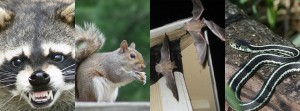Wild Life Management | Skunk, Raccoon, Snake and Gopher Removal MN
Wild animals contribute to our enjoyment of nature and outdoor recreation, but typically when they stay in the wild, not your home. They can also damage property, agriculture, and natural resources and threaten human health and safety. But even people who cherish wildlife will recognize the enormous amount of damage, not to mention frustration, animals can cause.
Living With Wild Life
Wildlife damage costs taxpayers millions of dollars every year in crop losses, and damage to homes and property.
Equipped with the right information and tools, most homeowners can solve their problems and learn to live with wildlife. For example, trimming trees and shrubbery can change a habitat and make it less attractive to unwanted birds or even snakes. Limiting food sources can deter predators or unwanted wildlife.
Homeowners can take specific steps to help keep curious raccoons out of the garbage, a persistent rabbit or deer out of the garden, waterfowl out of the backyard pool, a woodpecker off the siding, or a swooping bat out of the attic. Caution should always be taken to avoid overly aggressive animals.
Squirrels and Other Rodents
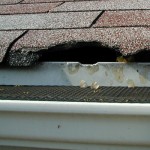 To keep squirrels and other animals from becoming a permanent part of the family home and yard, homeowners can screen louvers, vents, and fan openings; keep doors and windows in good repair; tighten eaves; replace rotten boards; cap chimneys; trim overhanging trees; remove bird feeders or use squirrel-proof feeders; and remove acorns and other nuts from the yard. Chipmunks can be deterred by removing denning habitat, which includes logs, rock walls, and stones.
To keep squirrels and other animals from becoming a permanent part of the family home and yard, homeowners can screen louvers, vents, and fan openings; keep doors and windows in good repair; tighten eaves; replace rotten boards; cap chimneys; trim overhanging trees; remove bird feeders or use squirrel-proof feeders; and remove acorns and other nuts from the yard. Chipmunks can be deterred by removing denning habitat, which includes logs, rock walls, and stones.
Mice
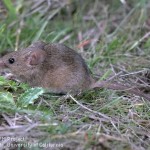 The last thing anyone wants to see crawling through their home is a mouse. These pests seem to be able to enter your home through virtually any crack or space, needing only a hole the size of a small marble. And once mice become a problem they can be extremely hard to get rid of. If in a home for a good period of time, a large amount of mice may be living in your attic, foundation or walls without home owners being aware of their presents or damage that is being done.
The last thing anyone wants to see crawling through their home is a mouse. These pests seem to be able to enter your home through virtually any crack or space, needing only a hole the size of a small marble. And once mice become a problem they can be extremely hard to get rid of. If in a home for a good period of time, a large amount of mice may be living in your attic, foundation or walls without home owners being aware of their presents or damage that is being done.
Adult House Mouse – House mice are frequently found in residential households. They lack a white underside and have a relatively hairless tail.
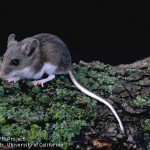 Worse, they spread disease to humans and other animals through their bite, by transporting fleas, lice, mites and ticks, and by leaving their droppings in food and other materials that humans contact. Rodents are vectors for bubonic plague, rat bite fever, leptospirosis, hantavirus, trichinosis, infectious jaundice, rat mite dermatitis, salmonellosis, pulmonary fever, and typhus.
Worse, they spread disease to humans and other animals through their bite, by transporting fleas, lice, mites and ticks, and by leaving their droppings in food and other materials that humans contact. Rodents are vectors for bubonic plague, rat bite fever, leptospirosis, hantavirus, trichinosis, infectious jaundice, rat mite dermatitis, salmonellosis, pulmonary fever, and typhus.
The deer mouse, and sometimes the white-footed mouse, are the mice primarily responsible for transmitting Hantavirus to humans. Mice have also been linked to asthma. Note the large ears and eyes and the white underside of the body and tail—all distinguishing characteristics between the deer mouse and house mouse.
Woodchucks
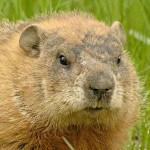 Woodchucks, also known as groundhogs, sometimes burrow near buildings, browse in gardens, and damage fruit trees and ornamental shrubs. Fencing can help reduce woodchuck damage. The lower edge should be buried at least 10 inches in the ground to prevent burrowing. The fence should be 3 to 4 feet high, with a surrounding electric hot-shot wire placed 4 to 5 inches off the ground.
Woodchucks, also known as groundhogs, sometimes burrow near buildings, browse in gardens, and damage fruit trees and ornamental shrubs. Fencing can help reduce woodchuck damage. The lower edge should be buried at least 10 inches in the ground to prevent burrowing. The fence should be 3 to 4 feet high, with a surrounding electric hot-shot wire placed 4 to 5 inches off the ground.
Opossums and Skunks
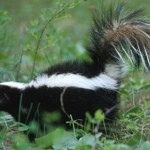 Opossums and skunks become a homeowner’s problem by raiding garbage cans and bird feeders; eating pet foods; and living under porches, or other areas that provide shelter. Skunks also dig in lawns, golf courses, and gardens. Both animals sometimes kill poultry and eat eggs. To keep opossums and skunks from denning under buildings, seal off all foundation openings with wire mesh, sheet metal, or concrete. Protect chicken coops by sealing all ground-level openings into the buildings and by closing the doors at night. Use tight-fitting lids and straps to eliminate foraging in garbage cans.
Opossums and skunks become a homeowner’s problem by raiding garbage cans and bird feeders; eating pet foods; and living under porches, or other areas that provide shelter. Skunks also dig in lawns, golf courses, and gardens. Both animals sometimes kill poultry and eat eggs. To keep opossums and skunks from denning under buildings, seal off all foundation openings with wire mesh, sheet metal, or concrete. Protect chicken coops by sealing all ground-level openings into the buildings and by closing the doors at night. Use tight-fitting lids and straps to eliminate foraging in garbage cans.
Bats
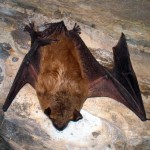 Bats prefer to avoid human contact; however, they are known to roost in attics and abandoned buildings. This can be eliminated by sealing entry and exit holes (after the bats leave) with such materials as 1/4-inch hardware cloth, caulking, or wire mesh. If a bat makes its way into the house, it can usually be encouraged to leave after dark by turning on lights and opening windows and doors.
Bats prefer to avoid human contact; however, they are known to roost in attics and abandoned buildings. This can be eliminated by sealing entry and exit holes (after the bats leave) with such materials as 1/4-inch hardware cloth, caulking, or wire mesh. If a bat makes its way into the house, it can usually be encouraged to leave after dark by turning on lights and opening windows and doors.
Waterfowl
Although most people find a few birds acceptable, problems quickly develop as bird numbers increase.
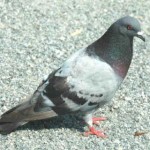 Damage includes overgrazing of grass and plants; accumulation of droppings and feathers; attacks on humans by aggressive birds; and the fouling of water, lawns, and recreational areas. Flocks of geese and other waterfowl also feed on various crops. Feeding of waterfowl may contribute to conflicts with humans.
Damage includes overgrazing of grass and plants; accumulation of droppings and feathers; attacks on humans by aggressive birds; and the fouling of water, lawns, and recreational areas. Flocks of geese and other waterfowl also feed on various crops. Feeding of waterfowl may contribute to conflicts with humans.
The Migratory Bird Treaty Act of 1918 and State laws protect all native waterfowl in the United States, including migratory and resident Canada geese. Under these laws, it is illegal to hunt, kill, sell, purchase, or possess migratory birds except as permitted by regulations enforced by the U.S. Department of the Interior’s Fish and Wildlife Service (FWS).
Individuals can conduct some management techniques independently, but wildlife professionals should carry out most waterfowl management activities.
Rabbits
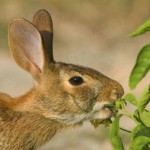 Rabbits can be kept away from gardens, ornamental plants, and small trees by using products containing repellents or by placing a 2-foot poultry fence around the area. The fence must be buried at least 6 inches beneath the ground surface. For information about taste repellents, check local garden or farm centers. Before using any chemical repellents, read the label carefully and check with your State pesticide regulatory agency for application guidelines.
Rabbits can be kept away from gardens, ornamental plants, and small trees by using products containing repellents or by placing a 2-foot poultry fence around the area. The fence must be buried at least 6 inches beneath the ground surface. For information about taste repellents, check local garden or farm centers. Before using any chemical repellents, read the label carefully and check with your State pesticide regulatory agency for application guidelines.
Raccoons
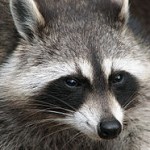 Easy food sources attract raccoons: garden produce, garbage, and pet food. To help prevent scavenging, use metal trash cans fastened to a pole or other solid object. A strap or latch should secure the lid. To keep raccoons out of the garden, use two strands of electric livestock fence placed 4 and 8 inches, respectively, off the ground, surrounding the entire garden. Exercise caution when implementing this exclusionary method in urban areas. Raccoons will also readily inhabit attics, chimneys, and sheds. Use metal flashing and 1-inch mesh hardware cloth to block entrances.
Easy food sources attract raccoons: garden produce, garbage, and pet food. To help prevent scavenging, use metal trash cans fastened to a pole or other solid object. A strap or latch should secure the lid. To keep raccoons out of the garden, use two strands of electric livestock fence placed 4 and 8 inches, respectively, off the ground, surrounding the entire garden. Exercise caution when implementing this exclusionary method in urban areas. Raccoons will also readily inhabit attics, chimneys, and sheds. Use metal flashing and 1-inch mesh hardware cloth to block entrances.
Snakes
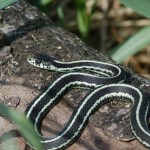 The best way to keep snakes out of a house is to seal cracks and openings around doors, windows, water pipes, attics, and foundations. A yard can be made less attractive by removing logs, woodpiles, and high grass and controlling insects and rodents. Remove nonpoisonous snakes from inside buildings by placing piles of damp burlap bags in areas where snakes have been seen. After the snakes have curled up beneath the bags, remove the bags and snakes from the building.
The best way to keep snakes out of a house is to seal cracks and openings around doors, windows, water pipes, attics, and foundations. A yard can be made less attractive by removing logs, woodpiles, and high grass and controlling insects and rodents. Remove nonpoisonous snakes from inside buildings by placing piles of damp burlap bags in areas where snakes have been seen. After the snakes have curled up beneath the bags, remove the bags and snakes from the building.
Woodpeckers
These birds damage buildings by drilling holes into wooden siding, eaves, or trim boards, especially those made of cedar or redwood. If the pecking creates a suitable cavity, the bird may use it for nesting. Effective methods for excluding woodpeckers include placing lightweight mesh nylon or plastic netting on the wooden siding beneath the eaves, covering pecked areas with metal sheathing, and using visual repellents like “eye-spot” balloons and Mylar strips.
Wild Animal Management Expert
Prevention is the best method of controlling these unwanted critters. Call a professional Minnesota wild animal management expert to remove them from your home.
Animal removal and animal control is closely regulated by the state of Minnesota to ensure humane and proper treatment of the wild animals removed. Hiring a Professional Pest or Wild animal control expert ensures that the proper control or disposal methods will be used.
They will have the tools and techniques to rid you of these unwanted pests once and for all. They will start by removing animals humanely all the way through repairing their damages and preventing it from happening again.

